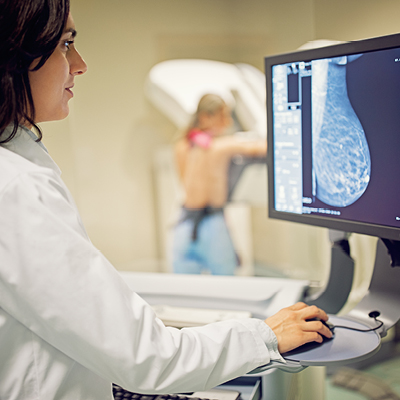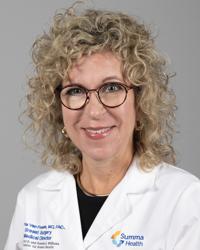What does "High Risk" for Breast Cancer really mean?
Posted October 17, 2021 by Victoria L. Van Fossen, MD

One out of every eight women will develop breast cancer in their lifetime; this is considered average risk for U.S. women. High risk for breast cancer is defined as a greater than or equal to 20% lifetime risk, or in other words, a one in five chance of developing breast cancer over a lifetime. We all know someone — a coworker, family member such as a mother, sister, daughter or friend — that has been diagnosed with this disease.
That’s why for decades, October and the color pink have gone hand in hand to promote Breast Cancer Awareness. Regular screenings and a healthy lifestyle have been shown to reduce a woman’s risk for developing breast cancer. In addition to these important actions, you need to be aware of our own individual lifetime risk for breast cancer. Summa Health answers your top questions about what it means to be high risk and how you can take charge of your breast health this month — and every month — to reduce your risk of breast cancer or detect it at its earliest stages when it is most treatable and curable.
How do I know my risk for Breast Cancer?
The risk for breast cancer is not the same for all women, as it depends on your individual health history and family history. A “high risk” designation can be determined by one factor or a combination of factors.
Even if you are in your 20’s and 30’s, a discussion with your healthcare provider about your individual breast cancer risk is encouraged. First and foremost, know your family history. This is an important initial step.
What factors increase my risk for Breast Cancer?
- Family history of breast and ovarian cancer. Your risk increases if a mother, sister or daughter is diagnosed with breast cancer. Red flags include multiple family members diagnosed at age < 45. Cancer risk can be inherited from your mother and father’s side of the family.
- Genetic mutations. You’re at a higher risk if you have family members with a mutation, especially BRCA1 and BRCA2 genes. Individuals with hereditary risk for breast cancer may have up to an 85% lifetime breast cancer risk.
- History of abnormal breast biopsy. Atypical cells put you at a higher risk.
- Dense breasts. Breasts comprised of more connective and glandular tissue and less fatty tissue have been associated with higher cancer risks.
- A high body mass index (BMI) of 25 or more. BMI is based on your weight in relation to your height and indicates if you’re at a healthy weight. The higher your BMI, the higher your risk for developing cancer.
- Increasing age. Two out of three invasive breast cancers are found in women over the age of 55.
- History of chest wall radiation at a young age. For example, chest radiation for childhood lymphoma increases breast cancer risk
Summa Health offers a Cancer Risk Assessment at all screening and diagnostic mammogram sites. This assessment analyzes your individual risk factors using sophisticated breast cancer risk models.
Based on your individual risk, your doctor will determine what preventive cancer screening is best for you, the frequency of screening and if you might benefit from genetic testing. There also may be lifestyle choices you can make to lower your risk and help prevent cancer.
What should I do if I am at High Risk for Breast Cancer?
If you’re at high risk for breast cancer, you and your healthcare provider will work together to develop an individualized prevention, screening and risk-reduction evaluation. This may include additional screenings like a breast MRI, or referral to a breast specialist, such as Summa Health’s High Risk Breast Clinic. The High Risk Breast Clinic provides on-site genetic risk evaluation, counseling and testing as well as screening and preventive options for women at increased risk of breast cancer.
A mammogram is the most important screening exam for early breast cancer detection. However, for women at high risk, there are additional screenings that your provider may recommend as a supplement to your yearly mammogram, including a screening breast MRI. A Breast MRI requires IV contrast and uses strong magnets instead of radiation to take detailed, cross-sectional images of the breasts to help radiologists see parts of the breast that may be hard to see with other imaging tests.
How can I lower my Breast Cancer Risk?
While not all risk factors can be modified, you can empower yourself and make sure your breast cancer risk is as low as possible by choosing the healthiest lifestyle options, including:
- Avoiding tobacco products
- Remaining at a healthy weight- especially avoiding postmenopausal weight gain
- Eating a healthy diet rich in plant based nutrients, reducing sugar, carbohydrates, red meats and processed foods
- Being physically active
- Limiting alcohol use
- Getting regular health screenings, including mammograms, preferably 3D
- Considering the risks vs. benefits of hormone replacement therapy and discussing them with your doctor
- Discussing with your provider risk reducing medications if you have had a high risk breast biopsy
- Prophylactic risk reducing surgery for women with genetic mutations that predispose to breast cancer
There is hope for reducing your risk of breast cancer. Take the next step and talk to your healthcare provider about identifying your lifetime risk and how you can work to decrease your chances of developing breast cancer.
For more information or to schedule an appointment or risk assessment with one of Summa Health’s high risk breast specialists, call 330.375.7494. Your physician can make a referral or you can self-refer.
About the Author
Vitality eNews Sign Up
Receive the Summa Health eNewsletter for the latest health tips, advice and updates.


